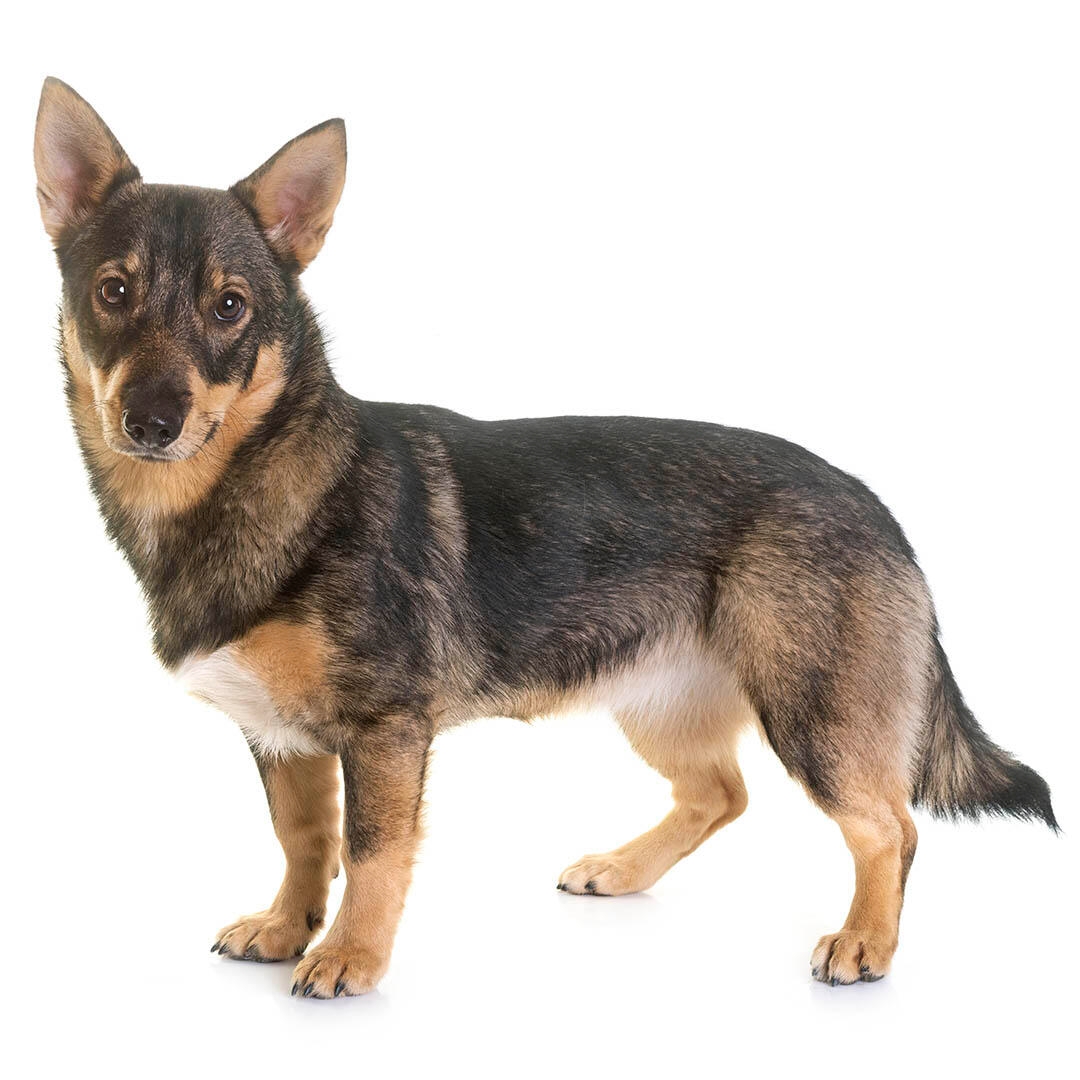
| Family-friendly: | 5/5 |
| Exercise needs: | 5/5 |
| Easy to train: | 5/5 |
| Tolerates being alone: | 3/5 |
| Likes other pets: | 3/5 |
| Energy level: | 5/5 |
| Grooming needs: | 4/5 |
| Shedding: | 4/5 |
The Swedish Vallhund breed is prone to:
- Hip dysplasia
- Breed specific retinopathy which is a form of progressive retinal atrophy which causes deterioration of the back of the eye.
- Progressive retinal atrophy which is an inherited disorder where part of the eye degenerates and wastes away which can result in blindness.
Priority Kennel Club health schemes and testing:
- Hip dysplasia screening scheme
- Eye screening scheme
Clever, lively and alert, the Vallhund is a natural watchdog, informing their owners of anything interesting, suspicious or unusual that they have seen or heard! Friendly and amenable, they are a loyal companion and enjoy spending time with their people. Easy to train with the right motivation, the Vallhund will enjoy a variety of doggy activities, but beware leaving a Vallhund to get lonely or bored – they will bark and become destructive if so!
| Family-friendly: | 5/5 |
| Exercise needs: | 5/5 |
| Easy to train: | 5/5 |
| Tolerates being alone: | 3/5 |
| Likes other pets: | 3/5 |
| Energy level: | 5/5 |
| Grooming needs: | 4/5 |
| Shedding: | 4/5 |
Also known as the Swedish Herder Spitz or the Swedish Cattle Dog, the Vallhund is thought to be almost 1000 years old. Believed to be related to the Pembroke Welsh Corgi (although opinions differ as to which came first), it is clear at a glance that the two breeds share some similarities in function and form.
The Vallhund’s original function was to herd and drive cattle but as a useful farm dog they would also perform the role of watchdog and ratter. Despite this usefulness, the breed nearly died out in the 1930’s but thanks to the efforts of Count Bjorn von Rosen and a group of dedicated supporters and breeders, numbers rose again and the Vallhund found favour as both a show dog and a family pet. Recognised by the Swedish Kennel Club in 1940, it wasn’t until the 1980’s that they achieved recognition by the UK Kennel Club.
Ideal Vallhund owners are those with Spitz breed experience and particularly the herding types of spitz breeds. You’ll have lots of time for long walks, be capable of training this somewhat independent minded breed to want to do what you want, and won’t mind the endless hair shedding all year round. Be ready to explain to strangers that this is not a Corgi or Corgi crossbreed, but in fact a breed in their own right as with all unusual breeds, there is always someone willing to offer you an opinion! Great for rural owners with large secure gardens, and either a child-free home or children old enough to help with training and exercise.
The Swedish Vallhund needs at least an hour of dog exercise as despite their small size this is a sturdy working dog. They will also require some form of mental stimulation on top of physical exercise to replace their daily engaging farm work. Intelligent and versatile, the Vallhund is capable of many canine sports and activities, from herding cattle or herding games such as Treiball/Sheepball, to agility, Hoopers, man-trailing and more. Some have even turned their paw to obedience.
The Vallhund is not a large dog and will not require a huge home, however a good-sized secure garden is a must. Given their tendency to bark, and desire to herd moving objects, they are probably better in a quieter location whether rural or suburban. Access to interesting and varied walking routes and secure locations for off lead play are essential.
The Swedish Vallhund needs to have a balanced diet including all the main nutrient groups and a constant supply of fresh water. It's also important to conduct regular body condition scores to ensure you keep your dog in ideal shape and remember to feed him at least twice daily and in accordance with the feeding guidelines of their particular food.
The low-maintenance coat of the Swedish Vallhund consists of a dense, soft undercoat and a harsh-textured, close topcoat. A weekly brush through is recommended. You can find out more about dog grooming and daily care with our article.
As a working dog, the Vallhund retains the ability to think and act independently which means owners should work hard to build a bond and motivate their dog to want to work with them. Consistency and positive reinforcement-based methods will be effective and will make dog training sessions with the Vallhund fun. Pay attention to training a solid recall as despite their short legs the Vallhund can be far away very quickly and has the stamina to keep going! Early dog socialisation with animals and people is essential, and you’ll need to be prepared to teach them only to herd on request, and to be quiet on cue!
The Swedish Vallhund makes an excellent family pet for those who enjoy walking and taking part in training or other dog related activities. Beware their desire to herd moving objects, and as cattle dogs, they are nimble, bold and not averse to nipping to make someone move and so are not good in families with small active children. Homes with older children, teenagers and those without children will find the Vallhund an engaging and intelligent companion who is affectionate and fun to live with.
While many dogs are traditionally thought of as being good with children, all dogs and children need to be taught to get on with each other and be safe together. Even so, dogs and young children should never be left alone together and adults should supervise all interactions between them.